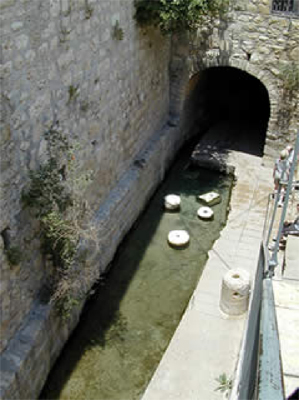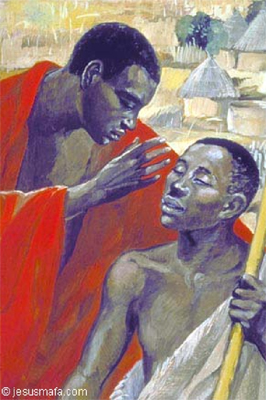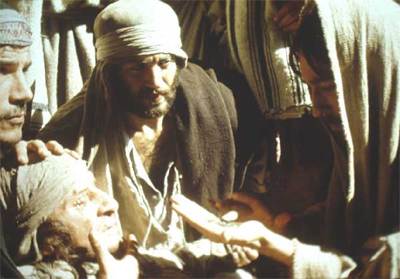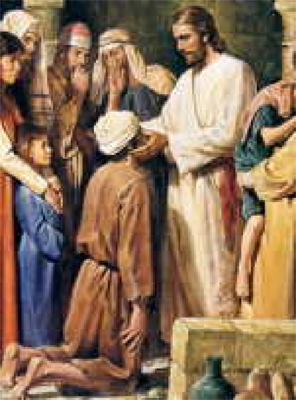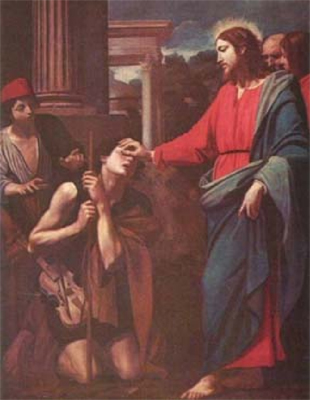
Christmas
Easter
Pentecost
All Saints
Christ The King
Confirmation
Palm/Passion
Reformation
Stewardship
Books of the Bible
Lenten Series
Christmas Dramas
Videos
Series A - Matthew
Series B - Mark
Series C - Luke
Series D - Other
To contact
Edward F. Markquart
info@sfs.com
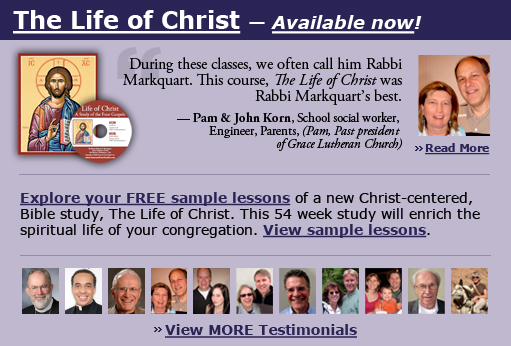
Series A
LENT 4A
John 9:1-41 The following Bible study is from a larger course entitled THE LIFE OF CHRIST: A Study in the Four Gospels. This 54 week course for the laity will be available for congregations in 2008. Basic text for the course: SYNOPSIS OF THE FOUR GOSPELS, Kurt Aland, English Edition, P. 11-12. John's Gospel And Jesus' Teachings At The Feast Of The Tabernacles In Jerusalem The Gospel Lesson for today is part of a section in the Gospel of John (7:1-10-21). In this particular section, we encounter Jesus teaching in the temple during the Feast of the Tabernacles. We are reminded that there are significant differences between the Gospel of John and the first three gospels.
In this section of his life, we encounter Jesus as being the Teacher in the Temple. The focus of his teaching is not on the kingdom of God and living a life ruled by God as in the synoptic gospels, but the focus of his teaching in the temple is on Jesus’ complex relationship with God the Father. We discover through these teachings of Jesus in the temple that:
It is clear that the focus of Jesus’ teachings in the Gospel of John is not on the Kingdom of God and how God rules us in our lives as we found in the first three gospels via his parables and teachings. Rather, the focus of Jesus’ teachings in the temple is on Jesus’ true identity and his relationship to God, the Father. Sometimes, we as common human beings, prefer Jesus’ simpler teachings about common life through his common parables (such as in the first three gospels) more than the philosophical complexities that he had in his relationship to his heavenly Father that is discussed in the Gospel of John. #248. Jesus Heals The Man Born Blind As a student of the Scriptures, we are aware that there is a contrast between Jesus' two healings of blind men, between the man born blind and the other shouting from the side of the road. Today, in the healing story of the man born blind, there is no expression of faith from the blind man. By contrast, when we study the story of blind Bartimaeus in Jericho, we will hear that classic phrase, “Your faith has made you well.” In the story of blind Bartimaeus, the blind man made a fuss in front of the Passover crowd and drew attention to himself as he begged Jesus to notice him. Blind Bartimaes took the initiative to attract Jesus’ attention, told Jesus he wanted to be healed of his blindness, and had great faith in Jesus, so much so that Jesus said, “Your faith has made you well.” We hear none of these themes in the story for today about the man born blind. As in many sections of the Gospel of John, there are two levels of understanding: the physical and the spiritual. In this section of John’s gospel, there is an interplay between physical blindness and spiritual blindness. -As he passed by, he saw a man blind from birth. His disciples asked him, “Rabbi, who sinned, this man or his parents that he was born blind.” As we have discussed earlier, most people, including Jesus’ disciples, thought the disease of blindness was caused by sin and was punishment for sin. The simple conclusion was that either this man sinned or his parents sinned. Many human beings have similar hidden prejudices that illness is a consequence of sinful behavior. Sometimes that is true. For example, a man dies of a liver disease and it may be from over drinking. A woman dies of lung cancer and it may be because she was addicted to smoking. But there are many diseases and accidents which happen which are not the result of sinful human irresponsibility but are just part of life. -Jesus answered, “It was not that this man sinned or his parents, but that the works of God might be manifest in him.” Rather than blaming either the man or his parents for sinning, Jesus said that God’s glory and power were going to be demonstrated through the healing of this man. That happens to us all the time. We experience an evil disaster in our lives. God takes that disaster and that disaster is transformed into an occasion where God’s glory, power and presence are revealed. For example, one of the worst disasters I have experienced was a car accident that killed two children, one who was seven years old and the other who was four. It was truly awful at the scene of the accident. On the first anniversary and fifth year anniversary of that terrible tragedy, family and friends gathered to remember the little girls and the tragedy of that sad day. In those anniversary remembrances, I heard personal stories from the parents, grandparents, and closest friends how the Lord God had strengthened and healed this family during the past year(s.) The sins of the little children, the parents or grandparents did not cause the tragedy of that awful car accident. But, you could clearly see God’s healing hand upon them all as they told their stories of God’ presence with them during that disaster and its aftermath. We all know this truth: God can make miracles from monstrosities. God can work deliverance even from disasters.
-We must work the works of him who sent me while it is day; night is coming when no one can work. The Lord God sent Jesus to earth to work miracles of beauty and to bring light to every person now, at this moment, in this situation. Jesus was doing the works of God when he healed the man born blind. -As long as I am in the world, I am the light of the world. Jesus is still in the world and is still our light within us to energize us, guide us, and grow us into goodness. Jesus also said that “I am the light of the world” in John 8:12. This section is a continuation of John 8:12. This is one of the seven “I AM” sayings of Jesus in the Gospel of John.
These are seven profound and self-revealing statements of Jesus. During this course and in coming lessons, we will pause at each of the seven statements and contemplate what Jesus was teaching about himself through this particular “I am” saying. From the very first verses in this gospel, the author knew that Jesus was the true light that enlightens every human being. Recall page 1, John 1:4-9 where God’s Word says: “In him was life and the life was the light of men. The light shines in the darkness and the darkness has now overcome it. … He (John the Baptist) came to bear witness to the light (Jesus) that all might believe through him. John (the Baptist) was not the light but came to bear witness to the light. The true light that enlightens every man was coming into the world." Jesus Christ is the true light that enlightens our world as we live in shadows of darkness and sin. Jesus Christ sheds true light on the nature of God, sheds light on the way to live a daily life, and sheds light about what happens after we die. Jesus is the true light and Jesus, the true light from God, wants to bring the light of love and truth into our lives. Jesus is the light of the world and he is going to bring light into the blind man’s eyes. He then spit on the ground and made clay and anointed the blind man’s eyes with clay. Jesus was light of the world who was coming so that all blind people might see the truth about God, life, eternal life, and that Jesus was sent from God and was/is the Son of God. Jesus came into the world to heal blind eyes and bring light into them. Earlier in the gospel of John, Jesus fed the 5000 and then gave a discourse on the “I am the Living Bread.” In this instance, Jesus healed the man born blind and then gave a discourse on “I am the light of the world.” The miracle and teaching are intricately interwoven. -As he said this, Jesus spat on the ground and made clay of the spittle and anointed the man’s eyes with clay. Jesus used spittle in the healing of a deaf mute (Mark 7:33) and in the healing of a blind man (Mark 8:23) “The Marcan spittle miracles seem to have been deliberately omitted by Matthew and Luke. The use of spittle was part of the primitive tradition about Jesus but left him open to a charge of engaging in magical practice.” (Raymond Brown, THE GOSPEL ACCORDING TO JOHN, V. I, p. 372) -Saying to him, “Go, wash in the pool of Siloam (which means Sent.) The pool of Siloam was an actual pool in Jesus’ day. Today, we can see archeological remnants of that pool. The pool was originally part of King Hezekiah’s tunnel. The scene of this miracle was not within the Temple. Rather, we find Jesus had walked through the city in a southwesterly direction to the southwest wall of the walled city of Jerusalem. This story of the healing of the man born blind occurred at the Pool of Siloam. In other words, this is another historical detail from an eyewitness who was on the scene. John was very specific in the location of this event of the healing of the man born blind. See #20 on the following diagram of the city of Jerusalem in order to ascertain the location of the pool of Siloam. #20 is located on the far right bottom corner of the diagram of the walled city of Jerusalem. It was part of King Hezekiah’s tunnel which was originally an aqueduct to bring water into the capital.
http://faculty.musowls.org/DentE/New%20Testament/Temple%20Diagram.htm From James B. Pritchard, The Harper Concise Atlas Of The Bible, p. 117 By carefully looking at the diagram above, you can see #20 (Pool of Siloam) on the right, lower corner of the model of the city of Jerusalem. You can easily imagine that Jesus had walked from the Temple area (#1) on a street to the pool of Siloam. Today, we can still see evidences of this ancient pool of Siloam as shown in the following two photographs.
http://www.facingthechallenge.org/siloam.htm (See this link.)http://www.facingthechallenge.org/arch2.htm “The pool of Siloam was (and still is) a real place in Jerusalem, at the southern end of the tunnel that King Hezekiah built to bring in water to the city when it was under seize by the Assyrians. Originally part of King Hezekiah’s tunnel, Siloam was excavated in 1880, complete with an inscription enabling its identification.” -So he went and washed and came back seeing. A miracle happened. Nobody can explain the miracle or fathom what actually happened. That is the way it was with miracles in Jesus’ day and still is today. Today, Jesus still comes to wash our eyes of our blindness so we can begin to see the truth that Jesus was talking about. Jesus wants to wash the blindness out of our eyes. Jesus came and still comes to us to enlighten our hearts and minds so that we can feel and see the miracles of God in our lives. -The neighbors and those who had seen him before as a beggar began to ask, "Is this not the man who used to sit and beg?" The blind man’s neighbors knew who he was and that he had been blind from birth and that he used to sit and beg at the Pool of Siloam. As we read this story, we need to remember that the details in this story are very graphic, as one would expect from the perspective of a person who was a first hand witness on the scene. John, the youngest disciple, was our reporter on the scene and he reports to us what he saw and experienced that day in the temple. Of course, the years have flown and John was an old man. But he clearly wants us to understand that Jesus could heal physical and spiritual blindness. He wants us to clearly understand that the Jews/Pharisees were blind. We also recall from the synoptic gospels that the disciples of Jesus were blind to who he really was and were blind to him being crucified on a cross and raised on the third day. In the Jesus Story, both the Jews and the disciples “didn’t get it” about the meaning of Jesus during his lifetime. -Some were saying, "It is he." -Others were saying, "No, but it is someone like him." Some folks didn’t believe that a miracle had occurred and that a man blind from birth had been healed. -He kept saying, "I am the man." The blind man kept on saying, “It’s me. I’m the guy. I am the who was healed. Yes, a miracle happened to me.” -But they kept asking him, "Then how were your eyes opened?" Circle the word, “how.” But the crowds weren’t so sure HOW it happened. The crowds asked a natural question: “If your eyes were healed, how did it happen?” That is the question that many of us still ask today? “How did it happen?” -He answered, "The man called Jesus made mud, spread it on my eyes, and said to me, "Go to Siloam and wash.' Then I went and washed and received my sight." The man answered, “Jesus. He is the one. I just followed his instructions and I was healed. Beats me how, but he did it.” -They said to him, "Where is he?" He said, "I do not know." -They brought to the Pharisees the man who had formerly been blind. Oh, oh, the temperature of the scene goes up immediately. -Now it was a Sabbath day when Jesus made the mud and opened his eyes. Then the Pharisees also began to ask him how he had received his sight. We have heard this theme before: Jesus healed a person on the Sabbath day. Jesus’ healings on the Sabbath day violated the Pharisees’ understanding of the law of God that a person could do no work on the Sabbath. Healing a person was considered “work” in the Pharisees’ eyes. To us, it is obvious that the Pharisees were blind to the true meaning of the Sabbath and God’s commanding us to have a day of rest. For the Pharisees, Jesus was a lawbreaker because he healed on the Sabbath and therefore was a sinner; that is, a person who did not obey God’s law. That was the Pharisee’s logic. -He said to them, "He put mud on my eyes. Then I washed, and now I see." -But others said, "How can a man who is a sinner perform such signs?" Jesus was considered to be a sinner because he broke the Sabbath laws by healing a man on the holy day when no one was to do any work. To do any work on the Sabbath day was sinful, including healing a man, so the blind Pharisees thought. -And they were divided. People are still divided about Jesus, who he is, who he was, whether or not he was from God, whether or not he was/is the Son of God, the Mind of God in human flesh. People still are divided about Jesus. -So they said again to the blind man, "What do you say about him? It was your eyes he opened." Not being able to solve the dilemma of Jesus’ identity, the crowds again went back to the healed man and questioned him. -He said, "He is a prophet." He didn’t know who Jesus was. Yes, “is a prophet,” one of the great leaders of the Jews in the past and now today, at this moment. He knew that Jesus was something special, and so he called him a prophet, the greatest human leader possible in the Jewish religion. -The Jews did not believe that he had been blind and had received his sight until they called the parents of the man who had received his sight and asked them, "Is this your son, who you say was born blind? How then does he now see?" The Jews were the leaders of the crowds in the temple. The Jews and Pharisees brought the parents of the young man to question them. Nobody really believed that the man born blind was really blind at birth. Who to ask? His parents, of course. -His parents answered, "We know that this is our son, and that he was born blind; His parents knew the answer to the question. Yes, their son was born blind. -but we do not know how it is that now he sees, nor do we know who opened his eyes. Ask him; he is of age. He will speak for himself." The HOW question again. The parents didn’t know how the son’s blind eyes could finally see. Neither did the son. Neither did the Jews. Neither did the neighbors. Nobody knew HOW the blind man’s eyes had been healed. -His parents said this because they were afraid of the Jews; for the Jews had already agreed that anyone who confessed Jesus to be the Messiah would be put out of the synagogue. Therefore his parents said, "He is of age; ask him." The parents were afraid to say that perhaps Jesus had healed their son because they knew the potential consequences, that they would be ostracized from the temple. -So for the second time they called the man who had been blind, and they said to him, "Give glory to God! We know that this man is a sinner." The reasoning of the Jewish leadership went like this: “Yes, we are to give God the glory when we receive a miracle from God. But such a miracle could not come from Jesus of Nazareth.” - He answered, "I do not know whether he is a sinner. One thing I do know, that though I was blind, now I see." The healed man did not know if Jesus was a sinner. All he knew that he had been blind from birth and now saw. -They said to him, "What did he do to you? How did he open your eyes?" The Jewish leaders were persistent in their interrogation of the healed man. - He answered them, "I have told you already, and you would not listen. Why do you want to hear it again? Do you also want to become his disciples?" He knew that such a comment would get the Jews’ dander up. -Then they reviled him, saying, "You are his disciple, but we are disciples of Moses. The Jews suspected that he healed man was already a disciple of Jesus, and perhaps was “a plant” to pretend that he was healed. The Jews were clear that they were disciples of Moses and the Old Testament. -We know that God has spoken to Moses, but as for this man, we do not know where he comes from." Through the whole Gospel of John, the problem with the Pharisees is that they didn’t know where Jesus had come from. -The man answered, "Here is an astonishing thing! You do not know where he comes from, and yet he opened my eyes. The healed man begins to show some starch, and begins to confront the Pharisees/the Jews. The issue is where Jesus came from, whether or not Jesus was from God. -We know that God does not listen to sinners, but he does listen to one who worships him and obeys his will. We know that Jesus was not a sinner and that he worshipped God and obeyed God’s will. -Never since the world began has it been heard that anyone opened the eyes of a person born blind. This was not any little simple miracle. The man who was healed thought this was a GRAND miracle, one of the most grand miracles of all time. - If this man were not from God, he could do nothing." This GRAND miracle “prove” to the healed man that Jesus was surely from God. -They answered him, "You were born entirely in sins, and are you trying to teach us?" Yes, the healed man was trying to teach the Pharisees. As we soon begin to understand, the Jews/the Pharisees were spiritually blind and could not see where Jesus was from nor his true identity. -And they drove him out. The Jews/Pharisees drove the man from the synagogue. If a you cannot address the arguments against you, get rid of the person who is arguing with you. -Jesus heard that they had driven him out, and when he found him, The man was driven outside the temple. Jesus was outside the temple and went and found the man. -he said, "Do you believe in the Son of Man?" The man would be perplexed by this question. He would think to himself, “Who ‘in the sam hill’ is the Son of man? What are you talking about?” Jesus clearly identified himself as the Son of man. We remember that Jesus repeatedly identified himself as the Son of man earlier in the first three gospels. The title, “Son of man,” is Jesus’ self designation. The Son of man was expected to come back to earth and judge the living at the dead at the end of history. Up to this point, the man born blind did not know that Jesus was the Son of man, the Messiah, the Anointed leader, the Son of God. According to the story, it was at this point that the blind man finally began to comprehend the true identity of Jesus and worshipped him. -He answered, "And who is he, sir? Tell me, so that I may believe in him." The man still did not know about the Son of Man. -Jesus said to him, "You have seen him, and the one speaking with you is he." Jesus clearly and unequivocally identified himself as the Son of Man. We know from other comments in the gospels that Jesus repeatedly and clearly identified himself as the Son of Man. The Son of Man was to come at the end of history to judge the living and the death. -He said, "Lord, I believe." And he worshiped him. That is what Jesus wants from us as well. Jesus wants us to come to that time in our lives when our spiritual blindness is healed and we call him “Lord.” This is what Jesus wants from us. Jesus wants to heal our blindness so that we too can believe in Christ and worship him as our Lord. That is what the Gospel of John and Christianity is all about. When Jesus heals our spiritual blindness, we gradually perceive who Jesus is. His Spirit, the Spirit of his love, then fills us. Like the healed blind man, we come to believe and worship him. We highlight that powerful word, “believe,” and remember that the words “believe, believing, faith, had faith” are use about 421 times in the New Testament. We remember our definition of the word, “believe:” TOKY which stands for Trust, Obey (love commandment), Know, and say Yes. There are four elements that compose the quality called “faith.” We are invited to have hearts that are filled with worship and praise, not only for God the Creator of the heavens and earth, but also for his Son, Jesus Christ, our Lord who was and is full of grace and truth. -Jesus said, "I came into this world for judgment so that those who do not see may see, and those who do see may become blind." This verse summarizes the whole story. Jesus, as the Son of Man, is the judge of people’s hearts. Jesus was sent from God to earth so that people would come to know the truth about God. We know from John 1:9, that Jesus came to this earth to bring light to every human being. That was his purpose, his destiny, his mission for life. -Some of the Pharisees near him heard this and said to him, "Surely we are not blind, are we?" At the end of this story, the Pharisees questioned: “Are we blind?” And Jesus answered, “You better believe it! You are blind!” The Pharisees countered Jesus, “How do you say we are blind? We are the faithful pillars of our synagogue. We faithfully attend worship each week. We pray every day. We give our ten percent, our tithe. We know our Bibles. How can you say that we are blind even though we worship faithfully, pray faithfully, give our money faithfully, and know our Bibles better than most folks? How dare you say that we are blind?” Jesus said, “I know you are very religious, but you still are blind.” The Pharisees suffered from spiritual blindness. They were blind to the Holy Spirit. They had religion but not the Holy Spirit. They loved their religious traditions but did not love their neighbor in need. They were blind to the suffering, pain and trauma of the enormous pain that was right before their eyes. They had no compassion in their hearts. They were truly blind to both the Holy Spirit and the human misery around them. We discover from this gospel story for today that people who go to church on a regular basis can still be blind.We are reminded that people who are religious, who attend worship regularly, give money, pray and know their Bible can be spiritually blind and be blind to the power of the Holy Spirit and to the misery around us. There is much spiritual blindness today in our world, both inside and outside the church. Perhaps the most awful disease in America today is spiritual blindness. That is what Mother Teresa said. The Pharisees had their blind spots and we too have personal blind spots. We have our blind spots in our religious beliefs and practices, in our marriages, in our parenting, in our work habits, in our personalities, especially in our personalities. I have my blind spots and you have your blind spots of your personality. Jesus wants to heal our blind spots. Painting And The Imagination:
http://www.jesusmafa.com/anglais/imag29.htm
http://www.excerptsofinri.com/images/509blindman.jpg
http://www.crossroadsinitiative.com/pics/content_img.2191.img.jpg
http://higherthings.org/imgs/se/katrina/blindman.jpghttp://imagesource.art.com
|
|

